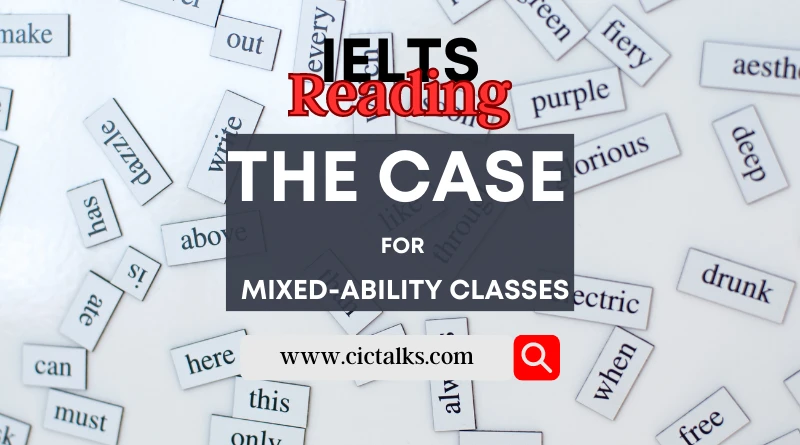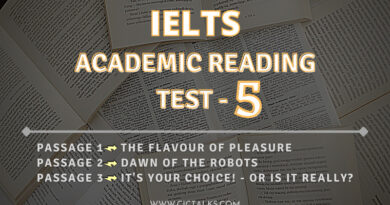The Case for Mixed-ability Classes – IELTS Reading With Answers
Practice The Case for Mixed-ability Classes IELTS Academic Reading with Answers, Explanation, and PDF.
The Case for Mixed-ability Classes
READING PASSAGE
Read The Case for Mixed-ability Classes Reading Passage below. You should spend about 20 minutes on the given questions.
Picture this scene. It’s an English literature lesson in a UK school, and the teacher has just read an extract from Shakespeare’s Romeo and Juliet with a class of 15-year-olds. He’s given some of the student copies of No Fear Shakespeare, a kid-friendly translation of the original. For three students, even these literacy demands are beyond them. Another girl simply can’t focus and he gives her pens and paper to draw with. The teacher can ask the No Fear group to identify the key characters and maybe provide a tentative plot summary. He can ask most of the class about character development, and five of them might be able to support their statements with textual evidence. Now two curious students are wondering whether Shakespeare advocates living a life of moderation or one of passionate engagement.
As a teacher myself, I’d think my lesson would be going rather well if the discussion went as described above. But wouldn’t this kind of class work better if there weren’t such a huge gap between the top and the bottom? If we put all the kids who needed literacy support into one class, and all the students who want to discuss the virtue of moderation into another?
The practice of ‘streaming’, or ‘tracking’, involves separating students into classes depending on their diagnosed levels of attainment. At a macro level, it requires the establishment of academically selective schools for the brightest students and comprehensive schools for the rest. Within schools, it means selecting students into a ‘stream’ of general ability, or ‘sets’ of subject specific ability. The practice is intuitively appealing to almost every stakeholder.
I have heard the mixed-ability model attacked by way of analogy: a group hike. The fittest in the group take the lead and set a brisk pace, only to have to stop and wait every 20 minutes. This is frustrating, and their enthusiasm wanes. Meanwhile, the slowest ones are not only embarrassed but physically struggling to keep up. What’s worse, they never get a long enough break. They honestly just want to quit. Hiking, they feel, is not for them.
Mixed-ability classes bore students, frustrate parents and bum out teachers. The brightest ones will never summit Mount Qomolangma, and the stragglers won’t enjoy the lovely stroll in the park they are perhaps more suited to. Individuals suffer at the demands of the collective, and mediocrity prevails. So: is learning like hiking?
The current pedagogical paradigm is arguably that of constructivism, which emerged out of the work of psychologist Lev Vygotsky. In the 1930s, Vygotsky emphasised the importance of targeting a student’s specific ‘zone of proximal development’ (ZPD). This is the gap between what they can achieve only with support – teachers, textbooks, worked examples, parents, and so on – and what they can achieve independently. The purpose of teaching is to provide and then gradually remove this ‘scaffolding’ until they are autonomous. If we accept this model, it follows that streaming students with similar ZPDs would be an efficient and effective solution. And that forcing everyone on the same hike – regardless of aptitude -would be madness.
Despite all this, there is limited empirical evidence to suggest that streaming results in better outcomes for students. Professor John Hattie, director of the Melbourne Education Research Institute, notes that ‘tracking has minimal effects on learning outcomes’. What is more, streaming appears to significantly – and negatively – affect those students assigned to the lowest sets. These students tend to have a much higher representation of low socioeconomic class. Less significant is the small benefit for those lucky clever students in the higher sets. The overall result is that the smart stay smart and the dumb get dumber, further entrenching the social divide.
In the latest update of Hattie’s influential meta-analysis of factors influencing student achievement, one of the most significant factors is the teachers’ estimate of achievement. Streaming students by diagnosed achievement automatically limits what the teacher feels the student is capable of. Meanwhile, in a mixed environment, teachers’ estimates need to be more diverse and flexible.
While streaming might seem to help teachers effectively target a student’s ZPD, it can underestimate the importance of peer-to-peer learning. A crucial aspect of constructivist theory is the role of the MKO – ‘more knowledgeable other ‘- in knowledge construction. While teachers are traditionally the MKOs in classrooms, the value of knowledgeable student peers must not go unrecognised either.
I find it amazing to watch students get over an idea to their peers in ways that I would never think of. They operate with different language tools and different social tools from teachers and, having just learned it themselves, they possess similar cognitive structures to their struggling classmates. There is also something exciting about passing on skills and knowledge that you yourself have just mastered – a certain pride and zeal, a certain freshness to the interaction between ‘teacher ‘ and ‘learner ‘ that is often lost by the expert for whom the steps are obvious and the joy of discovery forgotten.
Having a variety of different abilities in a collaborative learning environment provides valuable resources for helping students meet their learning needs, not to mention improving their communication and social skills. And today, more than ever, we need the many to flourish – not suffer at the expense of a few bright stars. Once a year, I go on a hike with my class, a mixed bunch of students. It is challenging. The fittest students realize they need to encourage the reluctant. There are lookouts who report back, and extra items to carry for others. We make it – together.
Questions 27-30
Choose the correct letter, A, B, C, or D.
Write the correct letter in boxes 27-30 on your answer sheet.
27. The writer describes the Romeo and Juliet lesson in order to demonstrate
A) how few students are interested in literature.
B) how a teacher handles a range of learning needs.
C) how unsuitable Shakespeare is for most teenagers.
D) how weaker students can disrupt their classmates’ learning.
28. What does the writer say about streaming in the third paragraph?
A) It has a very broad appeal.
B) It favours cleverer students.
C) It is relatively simple to implement.
D) It works better in some schools than others.
29. What idea is suggested by the reference to Mount Qomolangma in the fifth paragraph?
A) students following unsuitable paths
B) students attempting interesting tasks
C) students not achieving their full potential
D) students not being aware of their limitations
30. What does the word ‘scaffolding’ in the sixth paragraph refer to?
A) the factors which prevent a student from learning effectively
B) the environment where most of a student’s learning takes place
C) the assistance given to a student in their initial stages of learning
D) the setting of appropriate learning targets for a student’s aptitude
Questions 31-35
Complete the summary using the list of phrases, A-I, below.
Write the correct letter, A-I, in boxes 31-35 on your answer sheet.
| Is streaming effective? |
|---|
| According to Professor John Hattie of the Melbourne Education Research Institute, there is very little indication that streaming leads to 31 ………………… He points out that, in schools which use streaming, the most significant impact is on those students placed in the 32 ………………… , especially where a large proportion of them have 33 ………………… Meanwhile, for the 34 ………………… , there appears to be only minimal advantage. A further issue is that teachers tend to have 35 ………………… of students in streamed groups. |
A. wrong classes
B. lower expectations
C. average learners
D. bottom sets
E. brightest pupils
F. disadvantaged backgrounds
G. weaker students
H. higher achievements
I. positive impressions
Questions 36-40
Do the following statements agree with the views of the writer in Reading Passage The Case for Mixed-ability Classes ?
In boxes 36-40 on your answer sheet, write:
YES – if the statement agrees with the views of the writer
NO – if the statement contradicts the views of the writer
NOT GIVEN – if it is impossible to say what the writer thinks about this
- The Vygotsky model of education supports the concept of a mixed-ability class.
- Some teachers are uncertain about allowing students to take on MKO roles in the classroom.
- It can be rewarding to teach knowledge which you have only recently acquired.
- The priority should be to ensure that the highest-achieving students attain their goals.
- Taking part in collaborative outdoor activities with teachers and classmates can improve student outcomes in the classroom.
The Case for Mixed-ability Classes Reading Answers
| Question | Answer |
|---|---|
| 27 | B |
| 28 | A |
| 29 | C |
| 30 | C |
| 31 | H |
| 32 | D |
| 33 | F |
| 34 | E |
| 35 | B |
| 36 | NO |
| 37 | NOT GIVEN |
| 38 | YES |
| 39 | NO |
| 40 | NOT GIVEN |
The Case for Mixed-ability Classes Answer Explanation & PDF
The Case for Mixed-ability Classes Academic Reading test evaluates a variety of reading abilities, including your capacity to follow an argument and identify a writer’s viewpoint, attitude, or intent. When reading this passage about classes, it evaluates your ability to comprehend primary ideas, specifics, viewpoints, and implicit meanings.
If you have a doubt and seek an explanation to any answer whatsoever. Feel free to comment below 🙂
Tell us in the comments if you need The Case for Mixed-ability Classes Test PDF.
HERE’S ANOTHER READING PASSAGE Green Roofs THAT YOU MAY TRY!
ALL THE BEST!




